Uncover 7 Cybersecurity Predictions for 2025 and their impact on digital security.
Wiki Article
Future-Proof Your Service: Secret Cybersecurity Forecasts You Required to Know
As organizations face the increasing pace of electronic change, recognizing the developing landscape of cybersecurity is crucial for long-lasting strength. Predictions suggest a considerable uptick in AI-driven cyber hazards, together with enhanced regulatory analysis and the critical shift in the direction of No Depend on Style.Surge of AI-Driven Cyber Dangers

One of one of the most worrying growths is using AI in developing deepfakes and phishing schemes that are remarkably convincing. Cybercriminals can fabricate audio and video content, posing execs or relied on people, to manipulate victims into divulging delicate information or authorizing fraudulent purchases. In addition, AI-driven malware can adapt in real-time to avert discovery by standard protection procedures.
Organizations should recognize the urgent need to reinforce their cybersecurity structures to combat these developing risks. This includes investing in advanced threat discovery systems, cultivating a society of cybersecurity understanding, and executing robust incident feedback strategies. As the landscape of cyber risks transforms, proactive actions end up being necessary for protecting sensitive information and preserving company honesty in a significantly digital world.
Raised Emphasis on Data Personal Privacy
Exactly how can organizations effectively browse the growing focus on data privacy in today's electronic landscape? As regulatory structures develop and consumer assumptions rise, businesses have to prioritize durable data personal privacy techniques. This entails embracing comprehensive information administration plans that make certain the moral handling of personal information. Organizations should conduct normal audits to evaluate compliance with regulations such as GDPR and CCPA, determining potential vulnerabilities that can result in information breaches.Purchasing worker training is critical, as staff understanding straight impacts data security. Organizations needs to cultivate a culture of privacy, motivating staff members to understand the importance of securing sensitive info. Furthermore, leveraging modern technology to enhance data safety is crucial. Implementing sophisticated file encryption techniques and safe and secure information storage space solutions can significantly reduce dangers related to unauthorized gain access to.
Partnership with lawful and IT groups is essential to line up data personal privacy campaigns with business purposes. Organizations must additionally involve with stakeholders, consisting of customers, to communicate their dedication to information personal privacy transparently. By proactively attending to data privacy problems, organizations can develop count on and enhance their reputation, inevitably adding to long-lasting success in an increasingly scrutinized digital setting.
The Shift to Zero Trust Fund Design
In reaction to the evolving hazard landscape, organizations are increasingly taking on No Count on Style (ZTA) as an essential cybersecurity strategy. This strategy is asserted on the principle of "never ever trust, constantly confirm," which mandates continual confirmation of user identifications, devices, and information, no matter their area within or outside the network perimeter.Transitioning to ZTA entails carrying out identification and gain access to management (IAM) options, micro-segmentation, and least-privilege access controls. By granularly managing accessibility to resources, companies can mitigate the danger of insider risks and decrease the effect of exterior breaches. Moreover, ZTA encompasses durable surveillance and analytics abilities, permitting organizations to discover and react to anomalies in real-time.

The change to ZTA is additionally fueled by the enhancing adoption of cloud solutions and remote job, which have expanded the strike surface area (cyber resilience). Typical perimeter-based safety designs are insufficient in this brand-new landscape, making ZTA a more resistant and adaptive framework
As cyber hazards proceed to grow in sophistication, the fostering of No Count on concepts will be crucial for companies seeking to protect their properties and preserve governing compliance while making certain service connection in an uncertain atmosphere.
Regulatory Modifications on the Horizon

Upcoming regulations are anticipated to address an array of concerns, consisting of data privacy, violation notification, and case action protocols. The General Information Protection Guideline (GDPR) in Europe has set a precedent, and comparable structures are arising in various other regions, Deepfake Social Engineering Attacks such as the United States with the suggested federal personal privacy regulations. These laws frequently impose stringent charges for non-compliance, stressing the demand for companies to prioritize their cybersecurity actions.
Moreover, industries such as finance, healthcare, and vital facilities are most likely to deal with a lot more rigid needs, mirroring the delicate nature of the information they manage. Compliance will not merely be a legal obligation but a crucial component of building trust with customers and stakeholders. Organizations must remain in advance of these modifications, integrating regulative requirements into their cybersecurity approaches to make certain durability and secure their possessions efficiently.
Significance of Cybersecurity Training
Why is cybersecurity training a crucial part of an organization's defense method? In an era where cyber hazards are progressively sophisticated, companies must acknowledge that their employees are usually the very first line of defense. Efficient cybersecurity training equips personnel with the expertise to determine possible threats, such as phishing assaults, malware, and social design tactics.
By promoting a society of safety and security recognition, organizations can dramatically reduce the danger of human mistake, which is a leading root cause of information violations. Regular training sessions make sure that employees stay notified concerning the newest dangers and ideal practices, thus boosting their ability to respond properly to cases.
Moreover, cybersecurity training promotes compliance with regulative needs, reducing the risk of legal consequences and punitive damages. It additionally encourages employees to take ownership of their function in the organization's safety structure, bring about a proactive as opposed to reactive approach to cybersecurity.
Final Thought
To conclude, the evolving landscape of cybersecurity demands positive steps to attend to emerging dangers. The increase of AI-driven assaults, combined with increased data privacy concerns and the transition to Absolutely no Trust fund Style, demands a thorough strategy to protection. Organizations has to stay attentive in adjusting to regulative changes while prioritizing cybersecurity training for employees (cyber attacks). Emphasizing these approaches will certainly not only enhance business durability but additionally guard sensitive information against a significantly innovative range of cyber threats.Report this wiki page